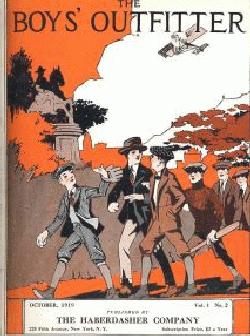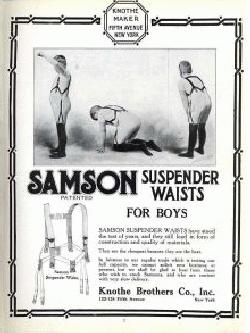began publishing in 1919 after World War I. We do not know how long it was published. The first six issues of The Boys' Outfitter ran from September 1919 to February 1920. I have not seen a lot of the issues or have any setails as to the the publishing dates. For a long time I on;y noted the early issues. I have since seen an issue published in the 1950s. It is the August 1950 issue. I do not know how long after that the magazine was published.
Periodicity
The magazine for a time was published monthy. I am not sure this monthly publishing continued for the entire press run.
Contents
The magazine a it was primarily designed as a marketing too was full of wonderful advertisements from manufacturers promoting thei line of boys cklothing. The magazine showed the latest boys' fashions, knicker suits, short pants, washable suits, norfolk suits, also blouses, hats and other accessories. There are also advertisements showing how boys' full-length stockings were held up with "suspender waists" for boys. (This was apparently the origin of the derisive term "pantywaist").
Trends
There were lots of articles about selling to boys (and mothers) and about the coming trends, what boys were wearing in England and France, store displays, etc. They were pushing the "new" short pants style.
Illustrations
The magazine was full of both illustrations and photographs. I am not sure who the illustrators were.
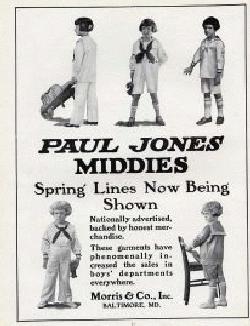
Figure 3.--Middy blouses for boys were still a popular style in the early 1920s.
|
Marketing
The American adverising industry came into its own in the 1920s as marketing became increasingly sophisticated. No company was on the cutting edge of the new marketing campaigns than Disney. Founder Walt (Walter Elias) Disney focused his energies on the creative process of animating film during the vintage years at the company. The person who was behind the very profitable proliferation of Disney merchandise from 1933-49
was primarily a a very creative salesman named Herman "Kay" Kamen (1892- ). It was the profits from the mercahndising that kept Disney in business during the early years. Walt Disney personally selected Kamen in 1932 to become the exclusive representative of the Disney character merchandising division of Walt Disney Enterprises.
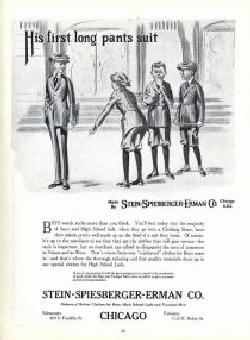
Figure 4.-- A boy's first long pants suit was a big deal in 1920. This is another advertisement from "The Boys' Outfitter". I think it is a suit manyfactuerer.
|
Both Walt and brother Roy Disney had heard of Kamen's reputation to promote retail dry goods, including children's toys and games. Kamen proceeded to emply the sales techniques available to him at the time,
primarily print media and radio. Kamen's reputation was made with advertising accounts during the 1920s with products featuring characters from Hal Roach's Our Gang. Farina, Buckwheat, Pete the Pit Bull, and the other Our Gang members were featured on a wide range of products, including playroom furniture sets, on dishware, as toys, in storybooks, in Big Little Books, and on back-to-school pencil boxes. Products even included Spanky Candy and Our Gang Chewing Gum. Kamen's advertising and public relations/promotions company was a partnership with Streeter Blair. They were originally based in Omaha and later in Kansas City. They went on to develop a huge overall sales campaign for retail stores nationwide. The partners' venture, called The Boys Outfitter used
an inovative sales technique that proved be quite effective. It involved both the retailer and the consumer. In a nation-wide marketing campaign, a comic character named Tim, who represented the all-American boy, and his sidekick dog, Pup, helped sell knickers, suspenders, caps, sweaters, shirts, socks, jackets, shoes and other boys' haberdashery items. Boys as part of the promotion could sign up and get an "Official Tim's Handbook", which included secret codes (very popular in the 1920s and 30s) and moral pointers for "good boys and pie-eaters." There were instructions on how boys could establish pie-eaters clubs in their own neighborhoods. By signing up, the boys provided a wonderfully targetted mailing list for Kamen's advertising. The clubs involved the moms, who were asked to bake the
pies and of course went shopping with their sons for his fall, winter, spring and summer outfits. They would received reminders in the mail from "The Boys Outfitter." This entire marketing system was developed and masterminded by Kamen, who never allowed a sales opportunity to elude him.
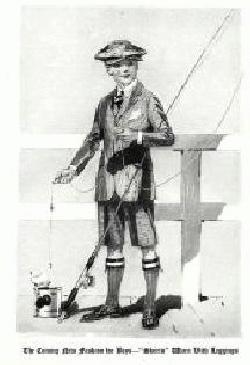
Figure 3.--"The Boys' Outfitter" in 1919-20 pushed the new short pants style that was becoming increasingly popular in Europe.
|
Articles
Here are some sample articles from the magazine.
A typical article in "The Boys' Outfitter" was "Shorts are Coming". "Foremost authorities in New York agree with this Magazine's prophecy --Origin "at the top of the trade" assures a lasting fashion --Now ten percent of demand in
exclusive shops --Buyers for them because boys want them --Economy in cost as important as greater comfort --Progressive departments will secure a supply
promptly. THE prediction in the January Boys' Outfitter that straight knee pants, or "shorts," are the coming thing was received with genuine interest throughout the trade.
There was a feeling akin to satisfaction that the tiresome sameness which has characterized all clothing for boys from ten to fifteen years of age was at last going to be
ended, that something had happened to dispute the sway of the Norfolk suit with its many-pleated, belted jacket and bloomer-like trousers.
A similar article begins, "DURING past years the boys' trade in this country has been like a ship without a rudder, so far as fashions are concerned, tossing aimlessly, fully equipped, but heading nowhere in particular; uncertain, careless at times as to the outcome, and always eager for a safe haven, but not able to attain it. In other words, the trade
was leaderless. This magazine, heavily handicapped, as it has been, in its "mewling" days, will co-ordinate ideas and set things straight. We shall soon have controversies in the trade as to whether a boy of ten should wear a vestee suit or whether a boy of fifteen should wear an Eton jacket-or a Tuxedo at his birthday party, and such matters of
proper usage. But, vastly more important, we shall see the boys' departments take on new life and interest under the inspiration of the only leadership in the field:
and, equally important, the trend of fashion will be sensed and chronicled and the production of novel, artistic and smart creations will become a matter of pride
among designers and tailors."
Reader Comments
A French reader writes, "What important work! One can find several analysis, information on American fashion. The extract and images are especially interesting. The fashion variations through time are fascinating. I found the information on American boys' fashions interesting to compare with our experiene here in France. One major difference was the long sockings and the suspender devices used o hold them up. These were unknown in France. We used buttons.
HBC

Navigate the Boys' Historical Clothing Web Site:
[Return to the Main U.S. fashion magazine country page]
[Return tp the Main fashion publishing page]
[Return tp the Main U.S. catalog page]
[Introduction]
[Activities]
[Biographies]
[Chronology]
[Clothing styles]
[Countries]
[Topics]
[Bibliographies]
[Contributions]
[FAQs]
[Glossaries]
[Satellite sites]
[Tools]
[Boys' Clothing Home]
Navigate the Boys' Historical Clothing Web Site:
[Sailor suits]
[Sailor hats]
[Buster Brown suits]
[Eton suits]
[Rompers]
[Tunics]
[Smocks]
[Pinafores]
Created: January 3, 2003
Last updated: April 15, 2004

